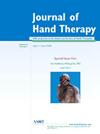偏重肌肉的手动疗法对肩周炎患者的肩关节运动学、肌肉表现、功能障碍和疼痛的影响。
IF 2.1
4区 医学
Q2 ORTHOPEDICS
引用次数: 0
摘要
背景:肩周炎(FS)以肩部主动和被动活动受限及疼痛为特征:肩周炎(FS)以肩部主动和被动活动受限及疼痛为特征。目的:比较肌肉偏倚手法治疗(MM)和常规物理治疗(RPT)对肩周炎患者的效果:研究设计:前测-后测对照组研究设计:我们招募了34名FS患者,并比较了为期12个疗程的MM和RPT的效果。结果测量指标包括肩胛骨运动学和肌肉激活、肩胛骨排列、肩关节活动范围和疼痛强度。采用双向方差分析来检验干预效果,α = 0.05:结果:两种方案对疼痛和肩部功能的改善效果相似。与 RPT 相比,MM 增加了后倾(MM:7.04°-16.09°,RPT:-2.50°至-4.37°;p = 0.002;ES = 0.261),降低了斜方肌激活(MM:260.61%-470.90%,RPT:322.64%-313.33%;p = 0.033;ES = 0.134),并且在手到颈任务中后倾增加(MM:0.70°-15.16°,RPT:-9.66°至-6.44°;p = 0.007;ES = 0.205)。MM 组的 GH 后仰(MM:37.18°-42.79°,RPT:43.64°-40.83°;p = 0.004,ES = 0.237)和肩胛骨下旋(MM:-2.48°至 6.80°,RPT:-1.93°-1.44°)也有所增加:MM:-2.48°至 6.80°,RPT:1.93°至 1.44°;P在肩胛骨神经肌肉表现方面,MM优于RPT。临床医生在治疗 FS 时应考虑增加以肌肉为基础的治疗。本文章由计算机程序翻译,如有差异,请以英文原文为准。
The effect of muscle-biased manual therapy on shoulder kinematics, muscle performance, functional impairment, and pain in patients with frozen shoulder
Background
Frozen shoulder (FS) is characterized by restricted active and passive shoulder mobility and pain.
Purpose
Compare the effect of muscle-biased manual therapy (MM) and regular physical therapy (RPT) in patients with FS.
Study Design
Pretest–post-test control group study design.
Methods
We recruited 34 patients with FS and compared the effect of 12-session MM and RPT. The outcome measures were scapular kinematics and muscle activation, scapular alignment, shoulder range of motion, and pain intensity. Two-way analysis of variance was used to examine the intervention effect with α = 0.05.
Results
Both programs resulted in similar improvements in pain and shoulder function. Compared to the RPT, MM resulted in increased posterior tilt (MM: 7.04°-16.09°, RPT: −2.50° to −4.37°; p = 0.002; ES = 0.261) and lower trapezius activation (MM: 260.61%-470.90%, RPT: 322.64%-313.33%; p = 0.033; ES = 0.134) during scaption, and increased posterior tilt (MM: 0.70°-15.16°, RPT: −9.66° to −6.44°; p = 0.007; ES = 0.205) during the hand-to-neck task. The MM group also showed increased GH backward elevation (MM: 37.18°-42.79°, RPT: 43.64°-40.83°; p = 0.004, ES = 0.237) and scapular downward rotation (MM: −2.48° to 6.80°, RPT: 1.93°-1.44°; p < 0.001; ES = 0.404) during the thumb-to-waist task, enhanced shoulder abduction (MM: 84.6°-102.3°, RPT: 85.1°-92.9°; p = 0.02; ES = 0.153), and improved scapular alignment (MM: 10.4-9.65 cm, RPT: 9.41-9.56 cm; p = 0.02; ES = 0.114).
Conclusions
MM was superior to the RPT regarding scapular neuromuscular performance. Clinicians should consider adding muscle-biased treatment when treating FS.
求助全文
通过发布文献求助,成功后即可免费获取论文全文。
去求助
来源期刊

Journal of Hand Therapy
医学-外科
CiteScore
3.50
自引率
10.00%
发文量
65
审稿时长
19.2 weeks
期刊介绍:
The Journal of Hand Therapy is designed for hand therapists, occupational and physical therapists, and other hand specialists involved in the rehabilitation of disabling hand problems. The Journal functions as a source of education and information by publishing scientific and clinical articles. Regular features include original reports, clinical reviews, case studies, editorials, and book reviews.
 求助内容:
求助内容: 应助结果提醒方式:
应助结果提醒方式:


